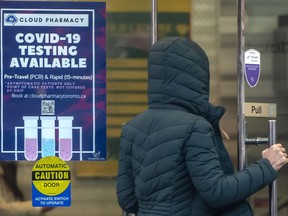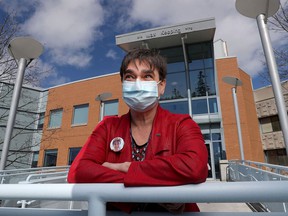Most hospitalizations at CHEO for COVID have occurred since December 1, 2021.

article content
The Omicron wave has had a disproportionate impact since it hit in December, putting more children in hospital and causing more deaths and infections among some populations than at any time during the 25-month COVID-19 pandemic.
Announcement 2
article content
Its symptoms are generally milder than with the previous variants, especially among people who are vaccinated. But Omicron spread so fast that more people were infected when it peaked in January than during previous waves, leading to more disruption and serious illness among children, some rural residents and frontline workers, among others.
The majority of hospitalizations at CHEO for COVID have occurred since December 1, 2021. The majority of COVID-related deaths in Renfrew County have also occurred since then. There were also more infections among healthcare workers and outbreaks in hospitals and long-term care during Omicron than any other wave.
The Ontario COVID-19 Scientific Advisory Board estimates that 20 to 30 percent of Ontario residents were infected with Omicron during the first wave that peaked in January, which should provide additional immunity.
Announcement 3
article content
Still, with a rapidly rising sixth wave now underway, partially fueled by Omicron’s even more transmissible BA.2 sub-variant, many are worried the province will take another hit. The serious impact of the first wave of Omicron could serve as a warning.
There are already signs that the sixth wave of COVID-19 will be intense. Hospitalizations, case counts, and signs of sewage are rising. There is a new round of outbreaks in long-term care homes and other congregate settings.
Between 20,000 and 30,000 people are infected in Ontario each day, experts estimate.
The current wave, characterized by Prime Minister Doug Ford this week as a “small spike”, is likely to last until early May, if it follows the pattern of previous waves.
Announcement 4
article content
And, as the latest wave grows, so do pediatric hospital visits across the province.
Based on hospital admissions, Omicron has, so far, hit children harder than all other COVID-19 variants combined. Three-quarters of all admissions to CHEO with COVID-19 during the pandemic occurred during the Omicron wave, according to hospital spokesman Patrick Moore.
Positive COVID admissions last week were the highest since January and early February, Moore said. On Tuesday, CHEO was caring for five children and youth with COVID-19 in inpatient units.
Across the province, a record number of young children have been hospitalized in recent days.

“Things are definitely looking up,” said Dr. Lindy Samson, a pediatric infectious disease specialist and CHEO chief of staff. “In the last week, we have seen similar numbers to what we had seen in mid-January and early February.”
ad 5
article content
Samson said the number of children and youth coming to CHEO’s emergency department with COVID-like symptoms is unprecedented in recent months. A third of about 5,000 ER visits since January were for children with symptoms consistent with COVID.
“That’s quite a few kids.”
She said the number of children admitted “for” COVID, as opposed to “with” COVID, has also increased in recent weeks. COVID admissions mean there is another primary reason for admission, but the child or youth also tested positive for COVID. Samson cautions that in many of those cases, COVID likely exacerbated an underlying health problem and may have caused the need for hospitalization.
Samson said he’s not aware of anything showing that Omicron or the BA.2 subvariant particularly targets younger children, making them sicker than previous variants.
ad 6
article content
“It has to do with how many people in the community are infected,” making it difficult for those who are not vaccinated to avoid it.
“Even if the virus is not more severe, the total number of people at risk of more severe illness is higher,” he said. That is reflected in the number of children admitted to hospitals.
Renfrew County, outside Ottawa, was also hit hard by Omicron, said Dr. Robert Cushman, acting Medical Officer of Health.
More than two-thirds of all deaths in the county, with a population of 108,000, occurred during the Omicron wave. Before December 1, there were 11 deaths in Renfrew. Since then, there have been 26 deaths.
“We had been doing really well through December,” Cushman said.
But Omicron hit hard. The worst pandemic month in Renfrew County was January and the second worst was December, for the number of serious illnesses.
ad 7
article content
That’s why Cushman is watching the current wave unfold with some concern and advising residents to get vaccinated if they aren’t, and to continue wearing masks.
“As we move forward, you have to be very vigilant.”
Cushman is blunt about the province’s decision to drop mask mandates in March while Omicron was still in wide circulation.
“I have always said that the province screwed up. They were a month early.”
Cushman said the province should have waited until at least the end of April to lift most mask mandates (masks are still required in higher-risk settings, including hospitals, long-term care and in transit).
“We have been wearing masks for two years, why not wait a few more months?”
He said he wants vaccination rates to increase, especially among Renfrew youth.
ad 8
article content
The highly contagious Omicron also hit healthcare workers hard. More than 17,000 Ontario healthcare workers have been infected since Dec. 1, according to the Ontario government. That represents 40 percent of all healthcare worker infections throughout the pandemic.
That high rate of infections for a relatively short time has left hospitals and other institutions scrambling to fill staffing gaps. Ottawa-area hospitals say they are again seeing high rates of absent staff related to COVID-19.
Outbreaks in hospitals, long-term care homes, and other congregate settings also reached record levels during the Omicron wave and, again, are beginning to rise.
Previously, the Ontario COVID-19 Scientific Advisory Board predicted that Ontario would see a small wave after lifting pandemic restrictions and increasing mobility, but it would not overwhelm hospitals.
Current data suggests that the sixth wave is larger and growing faster than the scientific table projected.
Reference-ottawacitizen.com